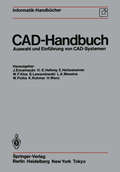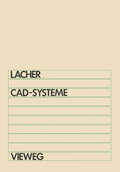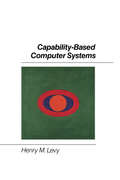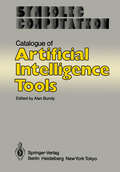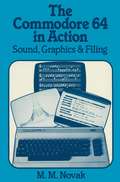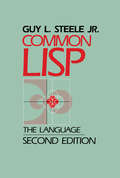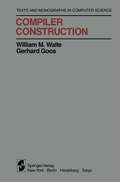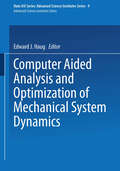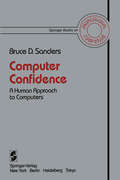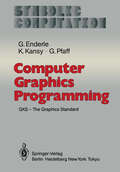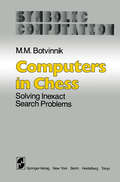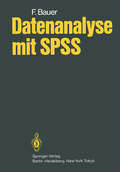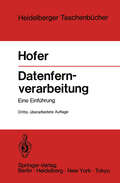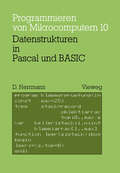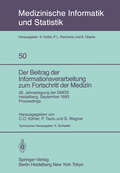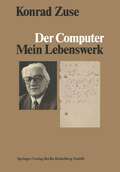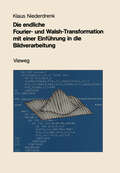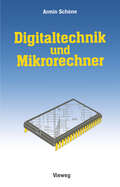- Table View
- List View
CAD-Handbuch: Auswahl und Einführung von CAD-Systemen (Informatik-Handbücher)
by J. Encarnacao H. E. Hellwig E. Hettesheimer W. F. Klos S. Lewandowski L. A. Messina W. Poths K. Rohmer H. WenzCapability-Based Computer Systems
by Henry M. LevyCapability-Based Computer Systems focuses on computer programs and their capabilities. The text first elaborates capability- and object-based system concepts, including capability-based systems, object-based approach, and summary. The book then describes early descriptor architectures and explains the Burroughs B5000, Rice University Computer, and Basic Language Machine. The text also focuses on early capability architectures. Dennis and Van Horn's Supervisor; CAL-TSS System; MIT PDP-1 Timesharing System; and Chicago Magic Number Machine are discussed. The book then describes Plessey System 250, Cambridge CAP Computer, and Hydra System. The selection also discusses STAROS System and IBM System/38. STAROS object support and abstract type management, as well as IBM System/38 profiles and authority and programs/procedures, are described. The book highlights Intel iAPX 432, and then considers segment and objects, program execution, storage resources, and abstraction support. Problems related with capability-based architectures are also noted. The text is a good source for readers wanting to study computer programming.
Catalogue of Artificial Intelligence Tools (Symbolic Computation)
by Lincoln WallenThe purpose of this catalogue is to promote interaction between members of the AI' community. It will do this by announcing the existence of Ai techniques and portable software. and acting as a pOinter into the literature. Thus the AI community wili have access to a common. extensional definition of the field. which will: promote a common terminology. discourage the reinvention of wheels. and act as a clearing house for ideas and software. The cataiogue is a reference work providing a quick guide to the AI tools available for different jobs. It is not intended to be a textbook like the Artificial Intelligence Handbook. It. intentionally. only provides a brief description of each tool. with no extended discussion of the historical origin of the tool or how it has been used in particular AI programs, The focus is on techniques abstracted from their historical origins. The original version of the catalogue. was hastily built in 1983 as part of the UK SERC-Dol. IKBS. Architecture Study [lKBS Architecture Study 831. it has now been adopted by the SERC Specially Promoted Programme in IKBS and is kept as an on line document undergoing constant revision and refinement and published as a paperback by Springer Verlag.
Common LISP: The Language (HP Technologies)
by Guy SteeleThe defacto standard - a must-have for all LISP programmers. In this greatly expanded edition of the defacto standard, you'll learn about the nearly 200 changes already made since original publication - and find out about gray areas likely to be revised later. Written by the Vice- Chairman of X3J13 (the ANSIcommittee responsible for the standardization of Common Lisp) and co-developer of the language itself, the new edition contains the entire text of the first edition plus six completely new chapters. They cover: - CLOS, the Common Lisp Object System, with new features to support function overloading and object-oriented programming, plus complete technical specifications * Loops, a powerful control structure for multiple variables * Conditions, a generalization of the error signaling mechanism * Series and generators * Plus other subjects not part of the ANSI standards but of interest to professional programmers. Throughout, you'll find fresh examples, additional clarifications, warnings, and tips - all presented with the author's customary vigor and wit.
Compiler Construction (Monographs in Computer Science)
by William M. Waite Gerhard GoosCompilers and operating systems constitute the basic interfaces between a programmer and the machine for which he is developing software. In this book we are concerned with the construction of the former. Our intent is to provide the reader with a firm theoretical basis for compiler construction and sound engineering principles for selecting alternate methods, imple menting them, and integrating them into a reliable, economically viable product. The emphasis is upon a clean decomposition employing modules that can be re-used for many compilers, separation of concerns to facilitate team programming, and flexibility to accommodate hardware and system constraints. A reader should be able to understand the questions he must ask when designing a compiler for language X on machine Y, what tradeoffs are possible, and what performance might be obtained. He should not feel that any part of the design rests on whim; each decision must be based upon specific, identifiable characteristics of the source and target languages or upon design goals of the compiler. The vast majority of computer professionals will never write a compiler. Nevertheless, study of compiler technology provides important benefits for almost everyone in the field . • It focuses attention on the basic relationships between languages and machines. Understanding of these relationships eases the inevitable tran sitions to new hardware and programming languages and improves a person's ability to make appropriate tradeoft's in design and implementa tion .
Computer Aided Analysis and Optimization of Mechanical System Dynamics (NATO ASI Subseries F: #9)
by E. J. HaugThese proceedings contain lectures presented at the NATO-NSF-ARO sponsored Advanced Study I~stitute on "Computer Aided Analysis and Optimization of Mechanical System Dynamics" held in Iowa City, Iowa, 1-12 August, 1983. Lectures were presented by free world leaders in the field of machine dynamics and optimization. Participants in the Institute were specialists from throughout NATO, many of whom presented contributed papers during the Institute and all of whom participated actively in discussions on technical aspects of the subject. The proceedings are organized into five parts, each addressing a technical aspect of the field of computational methods in dynamic analysis and design of mechanical systems. The introductory paper presented first in the text outlines some of the numerous technical considerations that must be given to organizing effective and efficient computational methods and computer codes to serve engineers in dynamic analysis and design of mechanical systems. Two substantially different approaches to the field are identified in this introduction and are given attention throughout the text. The first and most classical approach uses a minimal set of Lagrangian generalized coordinates to formulate equations of motion with a small number of constraints. The second method uses a maximal set of cartesian coordinates and leads to a large number of differential and algebraic constraint equations of rather simple form. These fundamentally different approaches and associated methods of symbolic computation, numerical integration, and use of computer graphics are addressed throughout the proceedings.
Computer Confidence: A Human Approach to Computers (Springer Books on Professional Computing)
by Bruce D. SandersMuch of the material in this book comes from what I've learned as I've traveled around the country conducting seminars about working profitably in the automated office. During the first few months of those seminars, there was a question I was asked more often than any other single question. I wa~ asked the question so often that I gave it a nickname. I called it my "What The Devil" question. Often in different words, usually at the morning break in the seminar, and almost always with an effort not to offend or embarrass, I was asked, "What the devil is a psychologist doing conducting seminars about computer systems?" I'm not asked "What the Devil" questions much anymore. Those familiar with office automation have come to realize that human factors chiefly determine whether a computer system will be a success or an expensive failure. So many computer systems have not gained acceptance by is employees because the planners didn't use good psychological sense. That especially true as the computers move from the Engineering Department into the executive suites and the role of computers changes from just producing paper into also assisting in managerial decision making. One human factor I've learned is that people would much rather skip around in a book than read it from front cover to back cover directly. It's true whether the book is a user manual for office equipment or a volume on computer systems for decision makers.
Computer Graphics Programming: GKS — The Graphics Standard (Symbolic Computation)
by G. Enderle K. Kansy G. PfaffFor several years the authors of this book have been involved in the design and the national and international review of the forthcoming graphical standard. When the end of this process could be foreseen and the International Standard "Graphical Kernel System" (GKS) was cast into its. final form, the urgent need arose for detailed information to the graphics community about this stan dard and for the education of graphics programmers. One major goal of GKS, besides the portability of graphical application programs and the device inde pendence, is "programmer portability" by establishing a common base for train ing of graphics programmers. Having accompanied the path of GKS from the very early stages of defining the basic concepts and designing its first versions up to the final draft of the International Standard, we feIt it worthwhile to start the venture of a text book on computer graphics programming based on GKS. This book is aimed, at one hand, at graphics users, experts and managers who want to get an overview of the new standard and a better understanding of its concepts. On the other hand, it addresses the graphics programmers who want to use GKS for realizing their graphical applications. It can serve as the base for teaching and studying functions, concepts and methods of GKS. Addi tionally, it will be a valuable source of information for implementors of GKS.
Computers in Chess: Solving Inexact Search Problems (Symbolic Computation)
by M. M. BotvinnikMuch water has flowed over the dam since this book went to press in Moscow. One might expect that PIONEER would have made substantial advances-unfortunately it has not. There are reasons: the difficulty of the problem, the disenchantment of the mathematicians (because of the delays and drawing out of the work), and principally the insufficiency and some times complete lack of machine time. The general method used by PIONEER to solve complex multidimen sional search problems had already been formulated at that time. It was supposed that the successful completion of the chess program PIONEER-l would provide a sufficient validation for the method. We did not succeed in completing it. But, unexpectedly, PIONEER's method obtained a different kind of validation. Since our group of mathematicians works at the Institute for Electroen ergy, we were invited to solve some energy-related problems and were assigned the task of constructing a program that would plan the recondi tioning of the equipment in power stations-initially for one month. Until then, the technicians had been preparing such plans without the aid of computers. Although the chess program was not complete even after ten years, the program PIONEER-2 for computing the monthly repair schedule for the Interconnected Power System of Russian Central was completed in a few months. In mid-October of 1980 a medium-speed computer constructed the plan in 40 seconds. When, at the end of the month, the mathematician A.
Countdown: Programme zur Bewegung von Fallschirmspringern, Raketen und Satelliten für programmierbare Taschenrechner und BASIC-Mikrocomputer
by Robert M. EisbergData Structures and Algorithms 1: Sorting and Searching (Monographs in Theoretical Computer Science. An EATCS Series #1)
by K. MehlhornThe design and analysis of data structures and efficient algorithms has gained considerable importance in recent years. The concept of "algorithm" is central in computer science, and "efficiency" is central in the world of money. I have organized the material in three volumes and nine chapters. Vol. 1: Sorting and Searching (chapters I to III) Vol. 2: Graph Algorithms and NP-completeness (chapters IV to VI) Vol. 3: Multi-dimensional Searching and Computational G- metry (chapters VII and VIII) Volumes 2 and 3 have volume 1 as a common basis but are indepen dent from each other. Most of volumes 2 and 3 can be understood without knowing volume 1 in detail. A general kowledge of algorith mic principles as laid out in chapter 1 or in many other books on algorithms and data structures suffices for most parts of volumes 2 and 3. The specific prerequisites for volumes 2 and 3 are listed in the prefaces to these volumes. In all three volumes we present and analyse many important efficient algorithms for the fundamental computa tional problems in the area. Efficiency is measured by the running time on a realistic model of a computing machine which we present in chapter I. Most of the algorithms presented are very recent inven tions; after all computer science is a very young field. There are hardly any theorems in this book which are older than 20 years and at least fifty percent of the material is younger than 10 years.
Data Structures and Algorithms 2: Graph Algorithms and NP-Completeness (Monographs in Theoretical Computer Science. An EATCS Series #2)
by K. MehlhornData Structures and Algorithms 3: Multi-dimensional Searching and Computational Geometry (Monographs in Theoretical Computer Science. An EATCS Series #3)
by K. MehlhornDatenfernverarbeitung: Außenstelle — Datenfernübertragung Rechenzentrum — Betriebsabwicklung Eine Einführung (Heidelberger Taschenbücher #120)
by H. HoferDatenstrukturen in Pascal und BASIC: mit 12 Pascal- und 8 BASIC-Programmen (Programmieren von Mikrocomputern)
by Dietmar HerrmannDatenverarbeitung im Luftverkehr (Programm Angewandte Informatik)
by Günther BecherDie Luftverkehrsgesellschaften gehören zu den Pionieren in der An wendung der automatisierten Datenverarbeitung. Sie haben neben ein fachen und gut strukturierten Abrechnungsaufgaben schon sehr früh komplexe und hochintegrierte Anwendungen mit ihrer Hilfe erschlossen. Beispiele hierfür sind die Flugreservierungssysteme der großen Ge sellschaften, die bereits seit Anfang der 60er Jahre im praktischen Einsatz sind, die Kommunikation zwischen den Gesellschaften innerhalb der IA T A, die sehr komplexen und aktuellen Dispositionsaufgaben, die beim Flugverkehr jeder großen Gesellschaft wahrzunehmen sind. Aus den Lösungskonzepten für diese wichtigen Problemstellungen konnten auch für anspruchsvolle Anwendungsbereiche in Wirtschaftsunterneh mungen und in der Wissenschaft vielerlei Anregungen gewonnen werden. Ebenfalls wurden dadurch die Entwicklungen bei den Herstellern von ADV Systemen maßgebend beeinflußt. VI Das vorliegende Buch gibt einen Überblick über die Aufgabenstellungen der Informationsverarbeitung bei Luftverkehrsgesellschaften. Ins besondere wird auch die Nutzung der Informationsverarbeitung aller großen internationalen Gesellschaften in sehr übersichtlicher Form herausgearbeitet, und es werden die verschiedenen Lösungen gegen übergestellt; außerdem erhält der Leser einen Überblick über die historische Entwicklung in diesem wichtigen Anwendungsbereich. Der Verfasser ist seit zwanzig Jahren für die Datenverarbeitung bei der Deutschen Lufthansa AG verantwortlich und jetzt im Vorstand dieser Ge sellschaft, wo er für die Bereiche Planung und Steuerung, Datenverar beitung und Fernmeldedienste, Rechnungswesen, Finanzen und das Justitiariat zuständig ist. Für den Themenbereich des Buches besitzt er eine sehr hohe Kompetenz. Wir sind überzeugt, daß er mit seiner Schrift auch außerhalb des Bereichs der Luftverkehrsgesellschaften auf sehr großes Interesse stoßen wird.
Der Beitrag der Informationsverarbeitung zum Fortschritt der Medizin: 28. Jahrestagung der GMDS, Heidelberg, 26.–28. September 1983 Proceedings (Medizinische Informatik, Biometrie und Epidemiologie #50)
by C. O. Köhler P. Tautu G. Wagner K. SchlaeferDer Simulator GPSS-FORTRAN Version 3 (Fachberichte Simulation #2)
by Bernd SchmidtAus den Besprechungen: "...Das vorliegende Buch geht von einer Vorstellung des zentralen Teils des Simulators, der Ablaufkontrolle, aus. Ihre Funktion zur Steuerung kontinuierlicher und diskreter Modellteile wird mit Hilfe von Beispielen in anschaulicher, gut verständlicher Weise erläutert. Diese Anschaulichkeit und die Nutzung von Beispielen zur Verdeutlichung von Datenstrukturen und Algorithmen zeichnen das ganze Buch aus...Zusammenfassend ist der vorliegende Band 2 der Fachberichte Simulation als eine gut lesbare Anwenderdokumentation des Simulators GPSS-FORTRAN zu bewerten, die Interessenten an diesem Simulator zur Information und Anwendern als Nachschlagewerk empfohlen werden kann." Fertigungstechnik und Betrieb#1
Die endliche Fourier- und Walsh-Transformation mit einer Einführung in die Bildverarbeitung: Eine anwendungsorientierte Darstellung mit FORTRAN 77-Programmen
by Klaus NiederdrenkDiscrete Systems: Analysis, Control and Optimization (Communications and Control Engineering)
by Magdi S Mahmoud M.G. SinghMore and more digital devices are being used for informa tion processing and control purposes in a variety of systems applications, including industrial processes, power networks, biological systems and communication networks. This trend has been helped by the advent of microprocessors and the consequent availability of cheap distributed computing power. For those applications, where digital devices are used, it is reasonable to model the system in discrete-time. In addition there are other application areas, e.g. econometric systems, business systems, certain command and control systems, environmental systems, where the underlying models are in discrete-time and here discrete-time approaches to analysis and control are the most appropriate. In order to deal with these two situations, there has been a lot of interest in developing techLiques which allow us to do analysis, design and control of discrete-time systems. This book provides a comprehensive treatment of discrete time dynamical systems. It covers the topics of modelling, optimization techniques and control design. The book is designed to serve as a text for teaching at the first year graduate level. The material included is organized into eight chapters.
